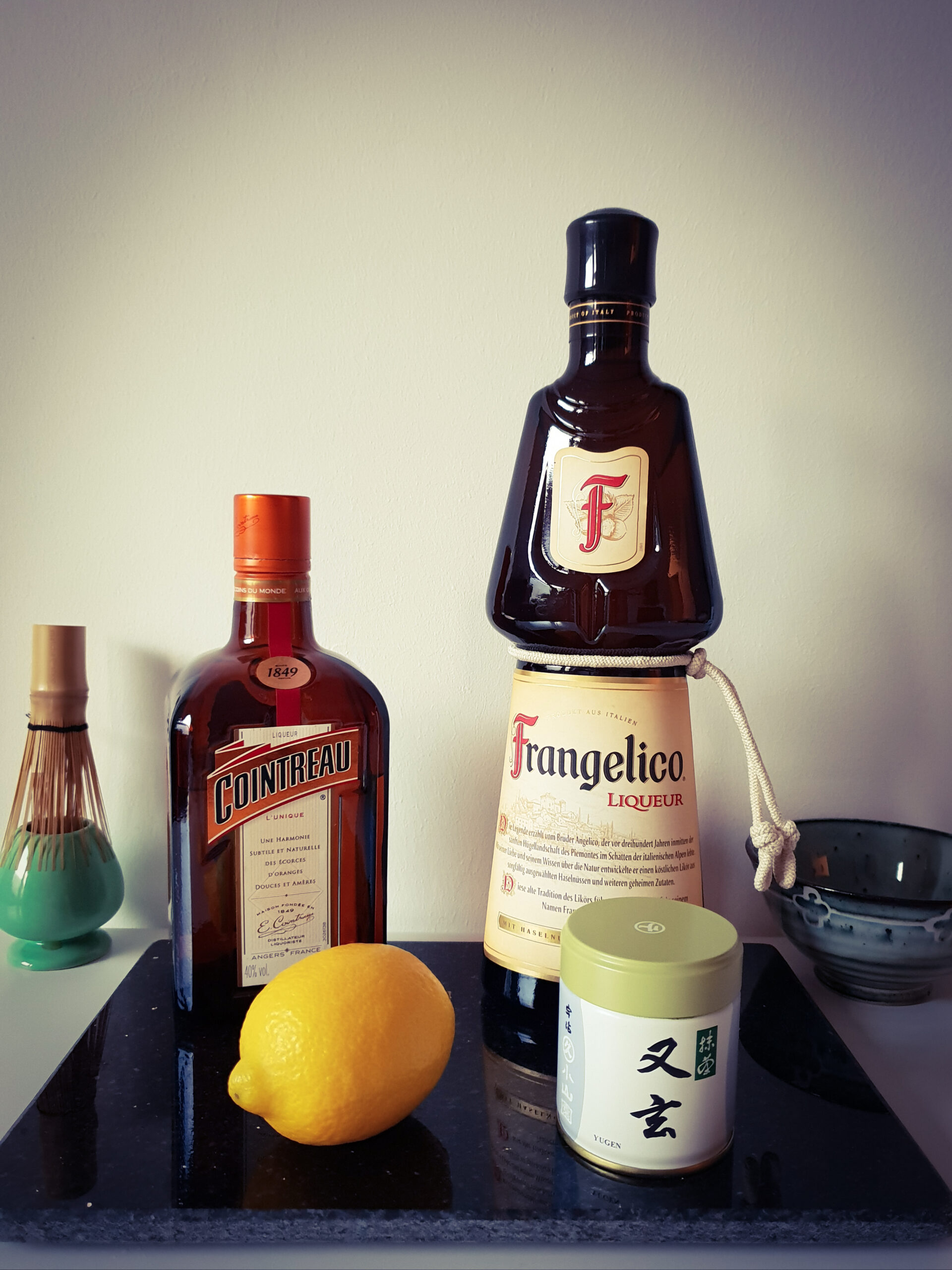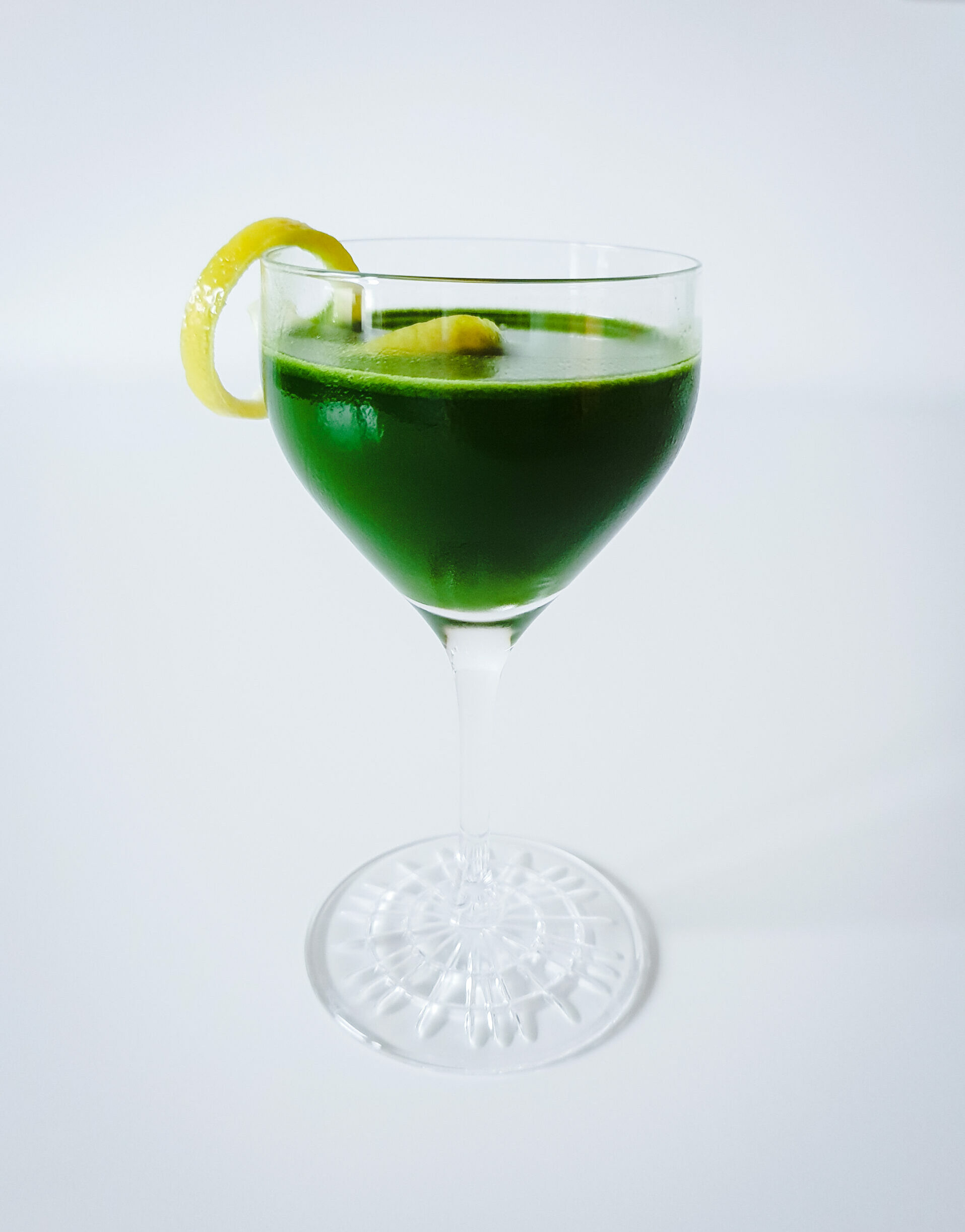Matcha green tea enriched by hazelnut & citrus fruits create a vivid, enlightening drinking experience
Matcha green tea enriched by hazelnut & citrus fruits create a vivid, enlightening drinking experience
Flavor profile
The idea
Similar to the Jade Peach, the Dancing Monk was at first inspired by the season of the year. At this colder time when different nuts are ready to be collected or even get roasted on Christmas markets. Bringing hazelnut and matcha together will let them combine their earthiness and even expand their richness (the nut in a more fatty/oily dimension though), whereas the tea flavor will be complemented by some light roasted, chocolate notes and, obviously, sweetness. Thinking of matcha lattes, you wouldn’t need long to find some with nut flavor, too. Frangelico is one of the most popular hazelnut liqueurs and has a wonderfully intensive, delicate hazelnut odor.
I decided not to apply a standard template with a base spirit this time, because when using something as rich as matcha & hazelnut, you don’t need vodka to fill it up or add the well-known rum or gin character. Instead, just let those two beauties shine and create something extraordinary. Adding fresh citrus juice, which goes especially well with hazelnut flavor, is moving the template towards a “sour”. But whereas the “Gin Sour” can be interesting enough due to the complexity of the main spirit, the “Frangelico Sour” lacks something special. That’s why e.g. the best version of the quite popular “Amaretto Sour” is not just adding lemon & sugar syrup but also lets Bourbon support. Thus, bringing Cointreau into the game generates the needed complexity with additional bitter notes and also lifts the alcohol content above kindergarten level. Orange goes similar well with hazelnut as citrus does and the two fruits are good partners as well, just think of all those modern classics like “Lemon Drop Martini”, “Long Island Ice Tea”, “Sidecar” & “White Lady”. When combining the two rather sweet liqueurs, sugar syrup is not needed anymore.
The result is an impressively rich drink with an intensive airy-creamy sensation on the tongue which also features the beloved counterplay of sweet & sour, with only a knife-edge victory for the sweet side. Btw, the Zen Monk does not only dance: in a similar blend, he will transcend (more cocktails to come)!
How to create it


0. Step: secure coldness
Put your cocktail glass (e.g. nick & nora or small coupette) in the fridge.
1. Step: whisk tea powder
Diffuse the matcha powder in the hazelnut liqueur inside a ceramic bowl, using a traditional Japanese bamboo chasen or a small standard whisk. Apply fast zigzag movement while some foamy texture appears on the surface.
2. Step: mix all
Put the hazelnut-matcha pairing, the Cointreau, and the citrus juice into a shaker and shake well with ice.
3. Step: serve & enjoy
Use a strainer to fine strain into your chilled cocktail glass & add a lemon zest as garnishing. Tip: flavor unfolds over time.
4. Step (optional): squeeze lemon zest
Peel the outer lemon skin (without the white pith) and squeeze the oil out of it on top of the drink.
Recipe
- 40ml hazelnut liqueur (e.g. Frangelico)
- 20ml orange liqueur (e.g. Cointreau)
- 10ml citrus juice (fresh)
- 1/2 bar spoon matcha powder (e.g. Yugen)
How to create it
0. Step: secure coldness
Put your cocktail glass (e.g. nick & nora or small coupette) in the fridge.
1. Step: whisk tea powder
Diffuse the matcha powder in the hazelnut liqueur inside a ceramic bowl, using a traditional Japanese bamboo chasen or a small standard whisk. Apply fast zigzag movement while some foamy texture appears on the surface.
2. Step: mix all
Put the hazelnut-matcha pairing, the Cointreau, and the citrus juice into a shaker and shake well with ice.
3. Step: serve & enjoy
Use a strainer to fine strain into your chilled cocktail glass & add a lemon zest as garnishing. Tip: flavor unfolds over time.
4. Step (optional): squeeze lemon zest
Peel the outer lemon skin (without the white pith) and squeeze the oil out of it on top of the drink.
The idea behind
Similar to the Jade Peach, the Dancing Monk was at first inspired by the season of the year. At this colder time when different nuts are ready to be collected or even get roasted on Christmas markets. Bringing hazelnut and matcha together will let them combine their earthiness and even expand their richness (the nut in a more fatty/oily dimension though), whereas the tea flavor will be complemented by some light roasted, chocolate notes and, obviously, sweetness. Thinking of matcha lattes, you wouldn’t need long to find some with nut flavor, too. Frangelico is one of the most popular hazelnut liqueurs and has a wonderfully intensive, delicate hazelnut odor.
I decided not to apply a standard template with a base spirit this time, because when using something as rich as matcha & hazelnut, you don’t need vodka to fill it up or add the well-known rum or gin character. Instead, just let those two beauties shine and create something extraordinary. Adding fresh citrus juice, which goes especially well with hazelnut flavor, is moving the template towards a “sour”. But whereas the “Gin Sour” can be interesting enough due to the complexity of the main spirit, the “Frangelico Sour” lacks something special. That’s why e.g. the best version of the quite popular “Amaretto Sour” is not just adding lemon & sugar syrup but also lets Bourbon support. Thus, bringing Cointreau into the game generates the needed complexity with additional bitter notes and also lifts the alcohol content above kindergarten level. Orange goes similar well with hazelnut as citrus does and the two fruits are good partners as well, just think of all those modern classics like “Lemon Drop Martini”, “Long Island Ice Tea”, “Sidecar” & “White Lady”. When combining the two rather sweet liqueurs, sugar syrup is not needed anymore.
The result is an impressively rich drink with an intensive airy-creamy sensation on the tongue which also features the beloved counterplay of sweet & sour, with only a knife-edge victory for the sweet side. Btw, the Zen Monk does not only dance: in a similar blend, he will transcend (more cocktails to come)!


